![]()
A Salute to

based on stories, inspirational pieces, cartoons,
and things that go bump in the night...by James Thurber
Sorry, as far as I know My World and Welcome to It cannot be found on video or DVD.
In 1969, television situation comedy was in transition. The era of the groundbreaking sitcom, heralded by All in the Family and followed by series such as Maude, Good Times, and Room 222, had not yet arrived. The genre was still winding down from a spate of series with magical characters/aliens/robots (My Favorite Martian, My Living Doll, My Mother the Car), although Bewitched was still going strong and there were series like The Ghost and Mrs. Muir entering a second season.
But by and large the 1969 sitcom family was still the Nelson/Cleaver type.
That year producer Sheldon Leonard (Make Room for Daddy) and writers Melville Shavelson and Danny Arnold (the latter who went on to do Barney Miller) came up with a whimsical, often sweetly cynical comedy about a writer/cartoonist and his home and office life, based on the writings of James Thurber. Entitled My World and Welcome to It, after one of Thurber's most famous story collections, it used animation to flesh out the main character's perplexity with life, using Thurber's cartoons and stories with full cooperation from the Thurber estate.
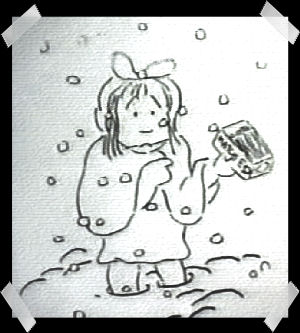
(Years later Ally McBeal's advertisers would promote the little cartoon fantasies that Ally had about her co-workers and acquaintances as something novel, forgetting that My World used the technique over 20 years earlier.)
John imagines a runaway Lydia's fate -->>
Premiering September of 1969, the series introduced us to John Monroe, a talented but often exasperated cartoonist/author who worked for a New York City magazine called The Manhattanite (based on Thurber's old stomping grounds, The New Yorker). At home in Connecticut he found his creativity plagued by his commonsense wife Ellen, who couldn't understand why her otherwise intelligent husband couldn't cope with the simplest of domestic chores, and his precocious daughter Lydia, who at ten was usually more interested in the status of war in the Middle East than in toys. While John loved his daughter, he certainly wasn't the dandling daddy type, something that alternatively bothered and relieved the child.
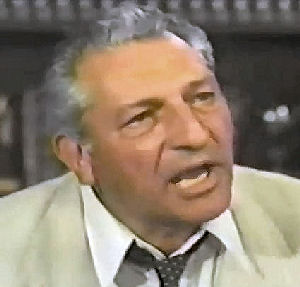
At work, John had to put up with his irascible editor, Hamilton Greeley, who usually suffered from a distinct lack of imagination--
<<-- Hamilton in his natural position: with his mouth open
Each episode combined several regular conventions. First, of course, was the use of animation based on Thurber cartoons, whether it be the entire tale of "The Unicorn in the Garden" as related to Lydia, or even as a basis for an entire episode, as was done with "The War Between Men and Women." Some episode teasers opened with John at the office, but a more common opener was that of John incorporated with Thurber's "Woman and House" cartoon. The opening credits involved a drowsy Thurber dog who is disturbed as the opening titles are scrolled around his sleeping place; the dog eventually finishes by "chasing" the Thurber name offscreen. The episode usually closed with animation of one of the characters coming out on stage and thanking the audience for watching, leading into a preview for the next week's episode.
Thurber stories also formed the basis for or were incorporated into episodes. In addition, John would usually "break the fourth wall" and talk directly to the audience about his predicaments and puzzles, as George Burns did a decade earlier in The George Burns and Gracie Allen Show.
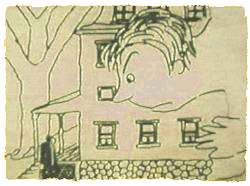
Ellen not pleased with the contents of John's shopping bag
Critics were delighted with the series and positive reviews showered each performance. The series had fair ratings and had squeaked by being scheduled by NBC for a second season when CBS abruptly cancelled the long running Red Skelton Show. NBC immediately signed Skelton to a half-hour series, but had to axe one of their lesser rated programs to do so. As luck had it, the unfortunate series was My World and Welcome to It, fresh from having won two Emmy awards, one for Best Comedy Series, one for William Windom as Best Actor in a Comedy Series.
(Either the Emmy Award committee had no inkling Windom would win the award, or they were so certain he would that they set up the presentation to best showcase a classic comedy moment: the actress who presented the award was none other than Eva Gabor. In her inimitable Hungarian accent, Windom's victorious vote came out as "And the vinner is Villiam Vindom for My Vorld and Velcome to It.")
Ironically, CBS had the last laugh: NBC's version of The Red Skelton Show died in the ratings and was gone after a year.
CBS repeated My World and Welcome to It during the summer of 1974 and it turned up occasionally on local stations, most recently in the early 90s on Chicago's WGN. Since then this clever series has vanished.
John Monroe: William Windom
Ellen Monroe: Joan Hotchkis
Lydia Monroe: Lisa Gerritsen
Hamilton Greeley: Harold J. Stone
Phil Jensen: Henry Morgan
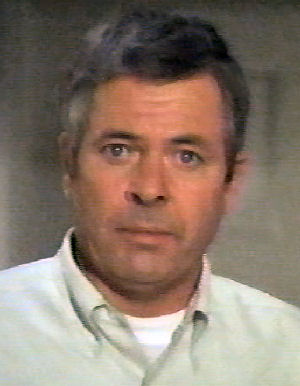
William Windom as John Monroe
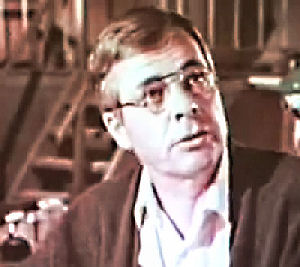
John at his desk.
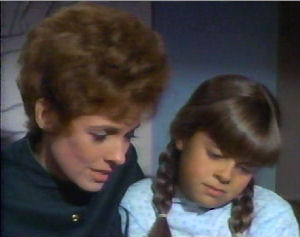
Ellen and Lydia read John's memorial to Christabel.
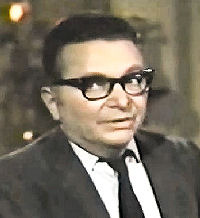
Robert Armin sent me this further information on "The Secret Life of John Monroe":
You might be interested to learn of the original "pilot" episode for what became My World and Welcome To It, produced in 1959 and aired on Alcoa/Goodyear Playhouse. Jules Goldstone, who acquired the rights from Thurber, produced the show and was given credit on My World as "Thurber material by arrangement with Jules Goldstone." Script Consultant: Melville Shavelson wrote the original pilot which starred Arthur O'Connell, Georgann Johnson and Susan Gordon as John, Ellen and Lydia Monroe.
The Secret Life of John Monroe (Unsold Pilot) (aka The Secret Life of James Thurber). This 30 minute pilot aired as the "Cristabel" episode of Alcoa/Goodyear Playhouse. Produced by Jules Goldstone for Screen Gems. Director: James Sheldon. Writer: Mel Shavelson, from the stories by James Thurber. Arthur O'Connell starred as magazine writer and cartoonist John Monroe whose fantasy world is illustrated by UPI animated cartoons based on his drawings. In this one and only episode, Monroe (O'Connell) refuses to allow his daughter Lydia (Susan Gordon) to have a dog, only to have the dog, Cristabel, die after he relents. Georgann Johnson played Ellen Monroe, Charles Herbert (of The Boy and the Pirates) was Charlie and Dabbs Greer played the Policeman. Broadcast on June 8, 1959.
This information can also be found on the Susan Gordon Tribute Pages
John about to have a confrontation with Hamilton
John and Lydia play chess—to his dismay she beats him!
Lydia looking adorable in her retainer
John is perturbed
Things are going Ellen's way
John tells Lydia one of his stories
Lydia stands up for her father, however perplexing she finds him
John comments on the state of modern medicine after he fetches medicine for Lydia's cold
Ellen perturbed about one of John's foibles
Lydia gives John an impish look after he helps her at school
John tells stories by drawing for Lydia
He tells her about his family and his grandfather...
...and the night the house caught fire
But it's the unicorn a man saw in his garden that makes her feel better
Unfortunately I own only six episodes on videotape (and those thanks to WGN), plus another on audio tape). The following is my guide to the episodes that I have on tape. The titles have been provided by Jim Beaty. Jim was kind enough to send me a copy of the series overview and episode guide that was provided in a My World and Welcome to It press kit that he purchased on e-Bay and said that I might use this information on my site. Please see the link below to read this information.
¤ "The Disenchanted," written by Ruth Brooks Flippen, directed by Danny Arnold.
John, tired of being interrupted at the office by the rumble of the freight elevator next to his office, decides to work at home, only to run into the problem of Lydia's dissatisfaction with her seat in school. When Lydia decides the only recourse is to run away, John accompanies her to the city, where she decides to settle with John's flamboyant sister Kate. Of course John ends up worrying more than Ellen does.
Aunt Kate: Carole Cook. Miss Skidmore: Lilian Field. Harry: Lenny Bremen.
"There are two things a wife can't stand: a husband coming home early or a husband coming home late. Oh, and one other thing: a husband coming home in the middle of the day."
¤ "Little Girls are Sugar and Spice—and Not Always Nice," written by Rick Mittleman, directed by Lee Philips.
John and Lydia seem to have no common ground in conversation—
Otto Bergmann: Oscar Beregi. First Man: Lew Gallo. Second Man: Lee Philips. Third Man: Leon Colker. First Woman: Gloria Lord. Second Woman: Mary Lou Taylor.
¤ "The Seal in the Bedroom," written by Paul Wayne, directed by Lee Philips.
At an editorial meeting, John and Hamilton bump heads over one of John's cartoons about a seal perched on the headboard of a couple's bed, and it doesn't help when Lydia and Ellen agree about the assessment. Then Phil tries to convince him that the seal is symbolic of John's mother coming between Ellen and himself and gives John a psychiatry book to read, and he's off and running.
Mrs. Monroe: Betty Kean. Writer: Sam Denoff.
Thurber's "Seal in the Bedroom," which provides the pivot to this episode, invited contention in real life: New Yorker editor Harold Ross didn't understand it, either. Some of the conversation in this episode comes directly from what happened when Ross first saw the drawing.
This may be the same San Denoff, who, with Bill Persky, created the series That Girl.
¤ "Christabel," written by Melville Shavelson, directed by Sheldon Leonard.
John is in the doghouse—
Veterinarian: Frank De Vol. Charlie: Richard Steele.
The other family dog is a bloodhound named Irving. The Thurber pieces used were "The Dog That Bit People," "The Topaz Cufflinks Mystery," and "Memorial."
Composer De Vol, who did such television themes as Petticoat Junction and Green Acres, often appeared as an actor as well. He was a regular on the series Camp Runamuck.
¤ "The Night the House Caught Fire," written and directed by Melville Shavelson.
Lydia is laid up with a bad cold and while Ellen does the shopping, John entertains her with tales to try to prove that people who daydream are far better off than "normal" people." When "The Unicorn in the Garden" fails to impress her, John relates a tale about his great-grandfather Skinner, who used to enthrall him with tales of his Civil War exploits.
Grandpa: Douglas V. Fowley. Little John: Bobby Riha. Roy Monroe: Billy Corcoran. Alexander: Vic Tayback. Fire Chief: Joe Besser. Fireman #1: Ralph Montgomery. Fireman #2: Ken Greenwald.
John on modern medicine: "Every time I hear of the Nobel Prize being awarded for medicine I think of the common cold...so far, the only progress made toward finding a cure for the common cold has been the totally inadvertant discovery that a hot rum toddy, taken occasionally, won't do a single bit of good, but it isn't a bad idea. However, in the case of juvenile victims, this method is frowned upon unless they can produce a driver's license. Has it ever occurred to you, as a reflection on our civilization, that no one in this country is allowed to become intoxicated until they've learned how to drive a car?"
John on imagination:
Lydia: "Daddy, are people who see things and daydream, are they, well, normal?"
John: "No, they're much better than that. Why, for heaven's sake, they're the artists, the poets, the bums, the cream of society. They get a lot more out of life than normal people. For one thing, they're never lonely or cold or hungry, because they've got their imagination to keep them warm and to keep them company. And, don't you believe for a minute that because they see things that you don't, that those things aren't there."John's parents, according to this, are named John and Agnes. (Agnes was the middle name of James Thurber's mother.)
¤ "The Shrike and the Chipmunks," written by Marion Hargrove, directed by Sheldon Leonard.
John is incensed when Hamilton decides to devote an entire issue of The Manhattanite to George Lindsay Lockhart, a children's book writer, whose next book will be illustrated by John. While Ellen and Lydia are charmed by Lockhart when he comes to visit, John is further irritated—
Lockhart: Paul Ford. Delivery Man: Dave Shelley.
The stories that Lockhart "writes" are actually Thurber's Fables for Our Time, specifically "The Shrike and the Chipmunks."
¤ "The War Between Men and Women," written by Rick Mittleman, directed by Alan Rifkin.
At their sixteenth anniversary party at the Monroe house, Phil Jensen finally "breaks" at his wife Ruth's habit of embellishing and interrupting his story and accidentally spills a drink on her. This, and a hostile encounter at the grocery store, result in an escalation of warfare between Phil, John, Hamilton, and J.J. Howard, a fellow writer, and Ruth, Ellen, Margaret, and Sylvia Howard when Ruth throws Phil out of the house.
J.J.: Ray Walston.
"The War Between Men and Women" forms the crux of this episode, but another Thurber piece used is "The Curb in the Sky."
Overview to series and episode guide from My World and Welcome to It press kit, provided by Jim Beaty. I have added some notes about Thurber stories when possible.
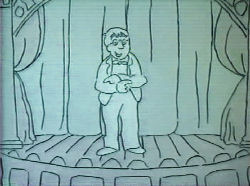
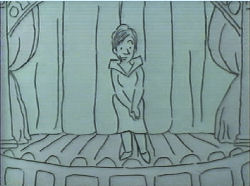
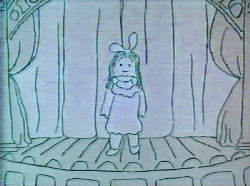
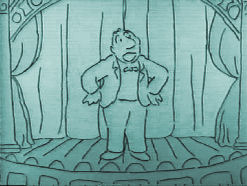
"Thank you for visiting this My World and Welcome to It web page.
Here are some other sites you might enjoy."
TV Party's My World and Welcome to It Page
TV Party's Fall reviews of the 60s contains a 2:19 minute preview of My World and Welcome to It which includes scenes from the pilot, "Little Girls Are Sugar and Spice — and Not Always Nice," and "Man Against the World"
Four photos from the My World and Welcome to It press kit, provided by Jim Beaty.
A Tribute to Thurber and Lisa Gerritsen, Gary Cahall
The Thurber House (a must-visit site for any Thurber fan)
| My World and Welcome to It is the property of Sheldon Leonard Productions/NBC Television. This is a fan page. No copyright infringment is intended. Any opinions stated are my own and do not reflect the thoughts of the creators or producers. |